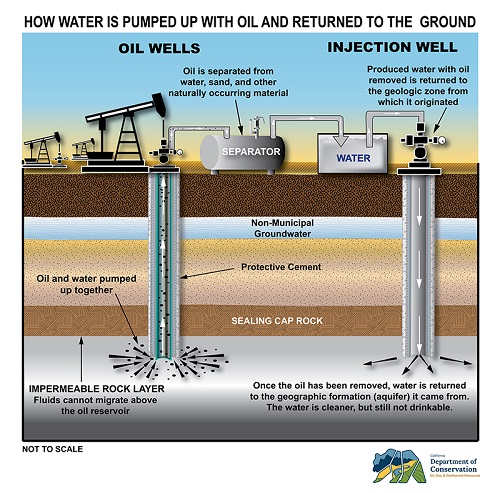Injection wells have been used in California for nearly 60 years. The Underground Injection Control (UIC) Program in the Geologic Energy Management Division (CalGEM) administers state regulations for the permitting, drilling, inspecting, testing, and sealing of these wells.
Update
SB 237 Public Workshop scheduled for January 13, 2026
The Department of Conservation, California Geologic Energy Management Division (CalGEM), Central District, is announcing an upcoming workshop to provide operators with information and guidance regarding Senate Bill 237 (SB 237) and its implementation in coordination with the Kern County Ordinance.
The workshop will focus on how SB 237 affects CalGEM permitting in Kern County, CEQA compliance, and Notice of Intention (NOI) processing for new wells, reworks, and abandonments, as well as Underground Injection Control (UIC) applications.
5:30 - 6:30 PM
Location: 11000 River Run Blvd.,
Bakersfield, CA 93311
Archived Actions/Information
April 2019 -- New UIC regulations took effect.
This UIC Workshop Presentation highlights those requirements and enhancements of prior regulations.
The regulations impact about 55,000 UIC wells in California. The regulations affect two types of wells: 1) those that inject water or steam for enhanced oil recovery and 2) those that return the briny groundwater that comes up from oil formations during production–typically unusable for drinking or agriculture–back into the underground source from which it came. A third category of UIC wells–those used for underground gas storage–is covered by separate regulations.
Key elements in the underground injection control (UIC) regulations include:
- Stronger testing requirements designed to identify potential leaks.
- Increased data requirements to ensure proposed projects are fully evaluated.
- Continuous well pressure monitoring.
- Requirements to automatically cease injection when there is a risk to safety or the environment.
- Requirements to disclose chemical additives for injection wells close to water supply wells.
Read more about CalGEM Statutes and Regulations.
UIC and Aquifers
Under the Safe Drinking Water Act (SDWA), the U.S. Environmental Protection Agency (EPA) has delegated primacy authority over oil and gas injection wells—categorized as Class II injection wells—to the CalGEM UIC Program. The program must prevent the degradation of underground sources of drinking water (aquifers) where there are injection operations.
The UIC Program processes aquifer exemption applications with the EPA to ensure California's compliance with federal law. The EPA may create exemptions under SDWA and allow the injection of fluids associated with oil production into certain aquifers. These aquifers are not sources of drinking water nor are they likely to be in the future because they naturally contain petroleum or high levels of elements such as arsenic or boron. CalGEM collaborates with the State Water Resources Control Board to ensure that any useful water is protected.
UIC staff works with other CalGEM units to collect and manage well data, enforce regulations, and conduct public outreach.

Memorandum Revision
In summer 2018, CalGEM and the State Water Resources Control Board (SWRCB) adopted revisions to the 1988 Memorandum of Agreement (MOA) regarding administration of the UIC program for Class II wells, discharges to land, and other related issues.
I
Additional Information
Oil and Gas Production: Water Use: Reporting, Senate Bill 1281 (Pavley, 2014)
U.S. Environmental Protection Agency: UIC and Drinking Water
Groundwater Protection Council
